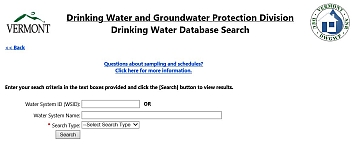A significant component of the Drinking Water and Groundwater Protection Division's mission is dedicated to implementing and managing the Vermont Vermont Water Supply Rule.
Purpose of this rule: First and foremost, the Vermont Water Supply Rule's primary purpose is to regulate public water systems in the state so that they may provide clean and safe drinking water to Vermont's citizens and visitors. The rule also establishes well construction standards.
Second, by implementing the rule, Vermont qualifies to retain "primacy" for the Safe Drinking Water Act from the federal U.S. Environmental Protection Agency (USEPA). Primacy means that the state will administer the federal regulations that apply to all public water systems, instead of USEPA.
Third, this rule makes it easier for both the regulators and the regulated community to carry out their respective roles.
The Division conducts the following duties in the interest of public health (relating to drinking water):
- Working with drinking water systems to maintain safe drinking water
- Sanitary surveys of public drinking water systems
- Administers various rules regarding the monitoring of water supplies
- Protecting groundwater and surface water sources
- Permitting for water system construction, operator certification, and well driller licensure
All water systems are initially classified as either Public Water Systems or Non-Public water systems. Classification as a Public water system depends on the number of service connections (15 or more) or people served (25 or more) by the system.
All public water systems must conduct required Water Quality Monitoring.
Information for Public Water System Operators pertaining to the training and certification of public water systems is available. All public water systems require a Certified Operator.
Capacity Development refers to a water system’s ability to adequately manage its technical, managerial and financial capabilities for the long-term.



